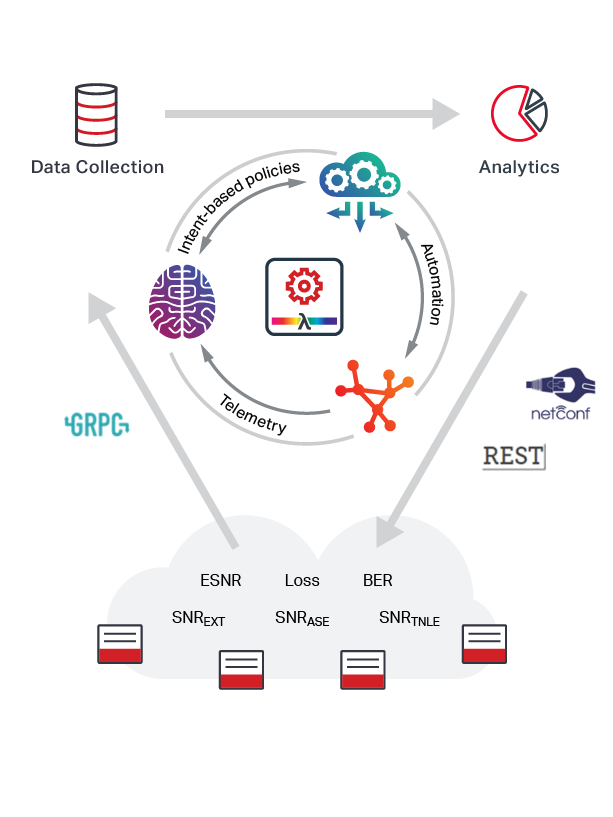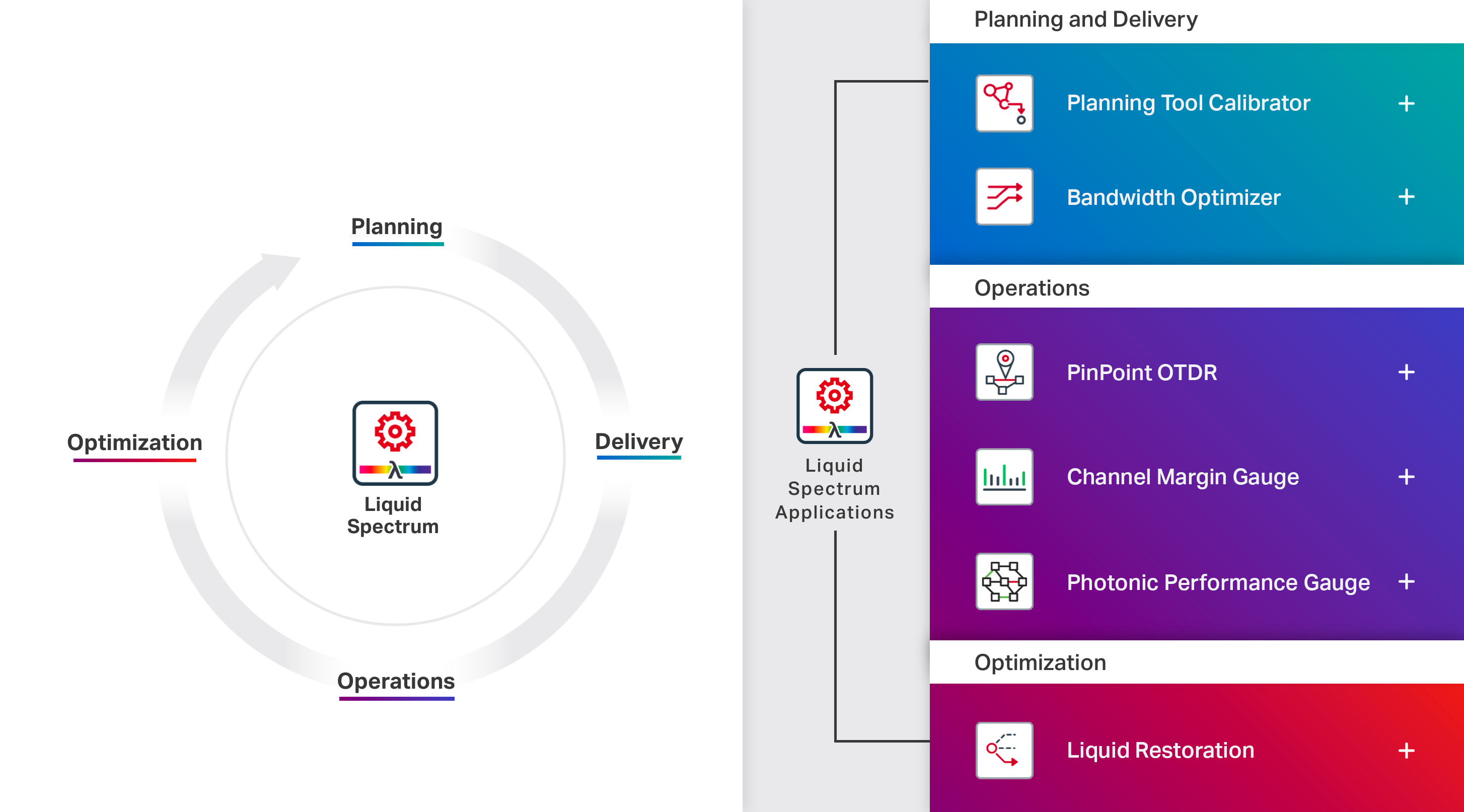What are advanced analytics in optical networking?
Advanced analytics take advantage of new in-service monitoring capabilities, programmable settings, and integrated instrumentation embedded in next-gen modems and line systems—combined with intelligent software automation—to provide a deep understanding of optical networks in real-time. These hardware and software advancements enable smarter, data-driven operational and business decisions, transforming next-gen photonic network operations by making it possible for network operators to do things like:
- Increase operational simplicity with real-time visibility into the health of the end-to-end optical network, including optical restoration paths before photonic restoration (with or without deployed transponders).
- Maximize ROI by leveraging existing, unused margin in the network to increase wavelength capacity, eliminating inefficiencies associated with an overbuild model.
- Increase market competitiveness by avoiding networking downtime and service disruption with the ability to detect potential photonic network problems, allowing for proactive maintenance.
Keeping pace with today’s ‘new normal’ customer demands for always-on, anywhere, reliable connectivity requires innovative technologies to deliver open, scalable, and programmable networks that can quickly adapt to changing customer requirements. State-of-the-art hardware, including next-gen coherent modems to drive down the cost of transport and reconfigurable open line systems, are key elements that enable a programmable optical infrastructure to address dynamic market demands. However, evolving toward a smarter optical network also requires software innovations that leverage advanced analytics with intelligent software automation to drive operational simplicity and actionable insights to maximize the efficiency of the network.
Evolving toward a smarter optical network also requires software innovations that leverage advanced analytics with intelligent software automation to drive operational simplicity and actionable insights to maximize the efficiency of the network.
Over the years, the optical layer has acquired an increasingly important role in networking. A key reason for that is that it provides the ability to scale to higher capacities and evolve to the latest coherent technology. And when the photonic layer is designed with flexible grid and colorless capabilities it offers signal independence—or the ability to transparently support multiple generations of transponders independent of format, bit rate, or symbol rate. However, the downside has been a lack of visibility—you don't really know what's happening to the signals as they go through all the photonic gear over the network.
Advanced analytics are changing the game in optical networking. Real-time data generated from next-gen coherent modems and line systems, combined with advanced photonic layer automation and open APIs, can speed up, automate, and reduce costs across photonic network operations. That enables network operators to do more with less—more capacity with fewer modems, more visibility with less complexity, and more flexibility with less intervention in the network.
systems, combined with advanced photonic layer automation and open APIs, can speed up, automate, and reduce costs across photonic network operations. That enables network operators to do more with less—more capacity with fewer modems, more visibility with less complexity, and more flexibility with less intervention in the network.
What does this translate to in a real optical network? It means that operators can enhance day-to-day operations with an instant health check into the performance of all active channels. Taking it one step further, operators can benefit from continued transport cost reduction with the ability to maximize capacity by converting available system margin into optical capacity for a given channel. It also means that operators can determine the system margin even before deploying wavelengths to proactively detect silent failures on restoration paths—a current blind spot in the network.
Ciena’s approach to advanced analytics in optical networking starts with the Manage, Control and Plan (MCP) SDN domain controller, laying the foundation for a software transformation of the network operations center. Liquid SpectrumTM—a suite of intelligent software applications that leverage a deep understanding of optical networking, predictive analytics, and advanced photonic layer automation to drive actionable insights—enables operators to make intelligent decisions based on the current state of the network. These sophisticated software applications also simplify operations by abstracting complexity associated with flexible next-generation technologies, and help providers extract the full value of their network assets. With these insights at their fingertips, providers can maximize network efficiencies throughout the life of their photonic network to gain increased capacity, stronger channel reach, faster troubleshooting, increased service availability, or increased automation for faster time to market.
Ciena’s Liquid Spectrum combines highly instrumented, programmable hardware and real-time analytics with advanced software applications to provide important benefits for operators thoughout the entire photonic network lifecyle.

Advanced applications include:
 Planning Tool Calibrator – Accesses real-time fiber characterization data and feeds it into planning tools to ensure optimal network designs—without relying on the manual link engineering and spreadsheet checking processes in use today.
Planning Tool Calibrator – Accesses real-time fiber characterization data and feeds it into planning tools to ensure optimal network designs—without relying on the manual link engineering and spreadsheet checking processes in use today. Bandwidth Optimizer – Simplifies and accelerates wavelength turn-up through real-time monitoring and automation, providing users with optimal capacity, spectral assignment, and equipment needs based on service requirements.
Bandwidth Optimizer – Simplifies and accelerates wavelength turn-up through real-time monitoring and automation, providing users with optimal capacity, spectral assignment, and equipment needs based on service requirements. PinPoint OTDR – Precisely localizes and addresses potential trouble spots, reducing the risk of outages and accelerating repair times from days to hours.
PinPoint OTDR – Precisely localizes and addresses potential trouble spots, reducing the risk of outages and accelerating repair times from days to hours.  Channel Margin Gauge – Provides operators instant visibility into the efficiency of their networks and lets them know if they can run their deployed optics at higher capacities
Channel Margin Gauge – Provides operators instant visibility into the efficiency of their networks and lets them know if they can run their deployed optics at higher capacities  Photonic Performance Gauge – Provides an instant health check of the photonic network, including optical restoration paths before photonic restoration, with unprecedented real-time visibility of photonic performance (even without active transponders).
Photonic Performance Gauge – Provides an instant health check of the photonic network, including optical restoration paths before photonic restoration, with unprecedented real-time visibility of photonic performance (even without active transponders). Wave-Line Synchronizer – Automates wavelength provisioning by matching transponder settings to the photonic line, reducing manual provisioning steps and eliminating associated human errors.
Wave-Line Synchronizer – Automates wavelength provisioning by matching transponder settings to the photonic line, reducing manual provisioning steps and eliminating associated human errors. Liquid Restoration – Increases service availability by leveraging existing system margin and flexibly adjusting transport capacity of deployed coherent optics to recover maximum traffic across any available path.
Liquid Restoration – Increases service availability by leveraging existing system margin and flexibly adjusting transport capacity of deployed coherent optics to recover maximum traffic across any available path.
As providers continue to evolve their networks leveraging the latest innovative technologies, advanced analytics and increased automation are required to fully operationalize and realize the benefits associated with a modernized network. Today, Liquid Spectrum apps are already being used across optical networks, making them smarter, enabling operators to make more intelligent decisions, and extracting the most value from existing network resources across the various stages of the photonic network lifecycle.





